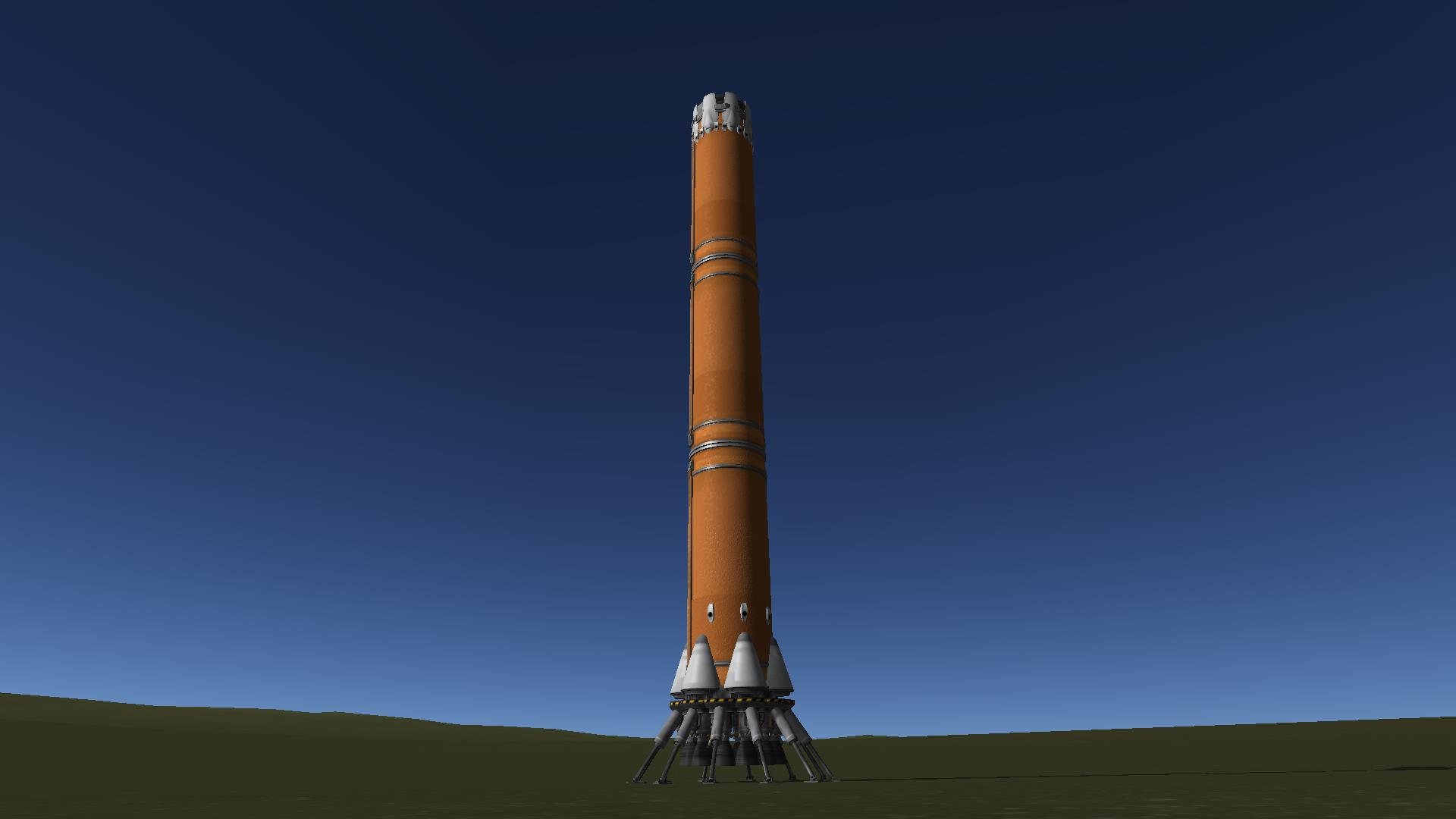Overview
A comprehensive guide on the finer points of making stock partially reusable rockets for the 10-15,000 kg class payloads using minimal mods.
Building the First Stage, Second Stage, and Example Payload
For the purposes of this guide, we can start by opening a new craft window in the VAB; starting with the first stage, we need to meet three basic guidance requirements: power, reaction wheels, probe control, and airbrakes.
In this case, there will be no need for RCS on this size first stage, because of the inherent aerodynamic stability of the rocket. Eventually, RCS would be required if you desired to land the first stage on drone ships. For our purposes, however, we will not be using RCS.
For propulsion, almost any engine combination works that lends the entire vehicle a TWR of at least 1.4 at launch. Ideally, the launch TWR of the rocket will be about 1.5. For the guide, I will be using two Vector engines due to the gimbal range.

For the example payload to practice with in sandbox mode, I would build a ~10,000 kg payload with batteries and a docking port.
For this size payload, a reasonably energetic upper stage is ideal. Here I use a Skipper Engine coupled with a Rockomax X-200-32 fuel tank. This configuration gives a high TWR (and, by extension, short burn time) and reasonable efficiency.
With proper staging, the fairing adjusted, and launch clamps attached, we are ready for launch.

Launching the Partially Reusable Rocket
Launching the rocket for the first time is an important step in first verifying the design, and beginning the troubleshooting process before a successful flight. In this case, upon launching this rocket we discover that it seems to possess a weak interstage section.
We can revert to the VAB to make accomodations for whatever adjustments we need. In this case, we just need to add struts between the stages.
For the sake of aesthetics, we can offset the struts into the vehicle. An important note here is that if you do more significant post-editing after offsetting the struts, they will not actually connect to each source connector through parts in between.

Attaining Orbital Velocity
After launching, we need to obtain a apogee of at least 72,000 meters in altitude. Also, for non-drone barge landings, the trajectory must follow downrange far enough so as to facilitate a ground landing.
Creating a maneuver node at apogee, a high TWR upper stage is ideal for making a high-DeltaV but fast burn into an LKO orbit. This burn should not typically be more than 900 m/s.
The bottom line for the upper stage burn time is that you need it to be complete before the first stage dips below 20,000 meters (at which point the game deletes non-active vessels formerly part of a rocket’s staging sequence).

Landing the First Stage
All previous steps in the process of building and flying do not require mods. In landing the first stage, however, it is highly suggested to use Kerbal Engineer Redux. It is not strictly required, as you can complete suicide burns without it, but it is much easier to have all that extra data available about trajectory and vehicle parameters. If you have Kerbal Engineer, you will not need any other mods for reliably nailing first stage landings.
Procedure-wise, for aiming at flat spaces to land on, you can adjust when in the trajectory you deploy the airbrakes. RCS is suggested for long glides because vernor engines provide the control authority required for more aggressive maneuvering.
After you experiment with differing airbrake deploy timings coming in to land using F5 and F9 to quicksave, you will want to perform a simple suicide burn. Keep in mind that the landing procedure will be the most quicksave-intensive part of flying a reusable rocket.
In general terms, some observation of real-life practices is useful for refining landing strategies. For example, burning at full thrust on a very rigorous suicide burn rather than a longer, more drawn out suicide burn increases efficiency. If you are landing with low fuel reserves, coming in fast like a Falcon 9 first stage is convenient. In this picture below, you can see that less than 20 out of 7200 fuel units are left in the tanks.
Cutting it this close is incredibly difficult without Kerbal Engineer, and the upshot is that it takes a lot of practice even with mods.
General Notes
With a 10-15,000 kg class payload, there will of course be a large amount of fuel left; this would facilitate beyond LKO maneuvering, like to the Mun or Minmus, or to space stations.
The 10-15,000 kg class payload restriction is only present for ground landings of this particular rocket. For example, you could add more fuel to first stage so as to facilitate heavier payloads and a ground landing, or simply soft water landings, and even precision drone barge landings.
If you found this guide helpful, please rate!











